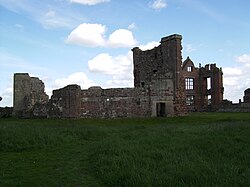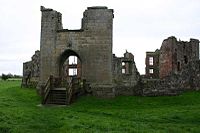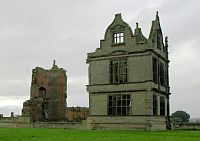Moreton Corbet Castle
| Moreton Corbet Castle | |
|
Shropshire | |
|---|---|
 Moreton Corbet Castle | |
| Type: | Castle |
| Location | |
| Grid reference: | SJ560232 |
| Location: | 52°48’16"N, 2°39’9"W |
| Village: | Moreton Corbet |
| History | |
| Information | |
| Condition: | Ruined |
| Owned by: | Corbet family (in the care of English Heritage) |
Moreton Corbet Castle is a castle ruin at Moreton Corbet in Shropshire, 8 miles northeast of Shrewsbury. The ruins on thwe site are in fact from two different eras: a mediæval stronghold and an Elizabethan era manor house.
The buildings have been out of use since the 18th century. Today they are in the care of English Heritage and a Grade I listed building.[1]
Contents
History
Mediæval Stronghold
The Domesday Book records in 1086 that Moreton Corbet was held by Hunning and Wulfgeat, though whether they had any fortification is doubtful. By the early twelfth century the manor was held by a landowner named Toret, and his descendant Peter Toret was lord of Moreton Corbet by 1166.
A castle had certainly been built by the opening of the thirteenth century, as the records tells that in February 1216, William Marshall stormed the castle on behalf of King John against Bartholomew Toret; at this time the castle was known as Moreton Toret Castle. In 1235 Bartholomew died and Richard de Corbet, his son-in-law, inherited the castle and changed its name to Moreton Corbet.[2]
The castle next saw action in the Civil War, during the course of which the castle changed hands at least four times.
Moreton Corbet remains the property of the Corbet baronets.
Elizabethan House
In the 16th century, Sir Andrew Corbet made many alterations to the gatehouse and the perimeter wall. When he died in 1579, his son, Robert Corbet (died 1583), influenced by the classical architecture overseas he had seen in his role as a diplomat, set about building a new mansion. Unfortunately, he died of the plague in 1583.[1] After his death, his two brothers and successors, Richard and Vincent Corbet, carried on with the building of the new manor, and leaving what was left of the original fortification.
Civil War
During the Civil War, Moreton Castle was used as part of Royalist Shrewsbury's defence. The castle was under siege on more than one occasion, and badly damaged in the fighting. At one time, the castle was captured by just ten parliamentary troops. The castle was finally taken from the local guard force which has garrisoned it by a crack Parliamentarian regiment.
The Ruins
The ruins can be visited during daylight hours free of charge.[3] There is visitor parking at the roadside west of the castle site.
The gatehouse was much rebuilt in the sixteenth century: this was the entrance to the mediæval building and retained and adapted by Sir Andrew Corbet. Above the arch, his monogram and the date 1579 are carved on the keystone (the year after his death). The gatehouse today is roofless and open.
The inner courtyard displays the layout of the mediæval castle. The keep or great tower to the west was connected to the gatehouse by an irregular and much rebuilt curtain wall, which then curved south and looped to encircle the site, creating a bailey or courtyard. The walls are now in a ruinous state, allowing the church to appear in the background. All the masonry is much pock-marked by musket shot from the Civil War. Sir Andrew had a large domestic range built against this wall, with kitchens below and accommodation above.
At the western end of the extant curtain wall stands a fine rectangular keep of two storeys and a basement. This could be as old as the eleventh century, although it more likely belongs to the twelfth.[1] or even early 13th.[4] It was entered through an elevated doorway and the fireplaces on the lower residential floor are still visible. The tower was much used and rebuilt, finally becoming a storehouse for the sixteenth century house. It was still inhabited about 1700.
In the courtyard to the east of the keep, Sir Andrew built his house. East and south of the gatehouse, these Tudor domestic ranges opened into a great hall. The large fireplace is apparent on the first floor, with a smaller one on the lower floor. Doorways were made through the curtain wall to the latrines.
South of the castle, Sir Andrew's son, Robert, who died in 1583, had a wide but shallow house built in a more modern style, described by William Camden as "a most gorgeous and stately house after the Italian model."[4] It seems to have been influenced by Italian buildings seen by Robert on his diplomatic travels, including Palladio's Basilica Palladiana in Vicenza. The building was faced with stone, but internally the walls were of brick. The house is badly damaged and the western end is most complete. Viewing obliquely from the west then gives a fair impression of the original design. Although Italian in inspiration and elaborately decorated, much of the carving was of a rustic finish.[4]
The house today
Although repaired after the Civil War, the buildings fell into disuse during the 18th century, and were partially demolished. They are still owned by the Corbet Family, but managed by English Heritage. The family moved to Acton Reynald Hall in about 1800.
Outside links
| ("Wikimedia Commons" has material about Moreton Corbet Castle) |
- Moreton Corbet Castle – English Heritage
- Moreton Corbet Castle
- Bibliography of sources relating to Moreton Corbet Castle
- Pictures of Moreton Corbet Castle and the area on Geograph.co.uk
- Moreton Corbet Castle Video & 360 Degree Panoramas
References
- ↑ 1.0 1.1 1.2 National Heritage List 1366802: Moreton Corbet Castle
- ↑ Remfry, Paul Martin (2005). Moreton Corbet Castle, and the families of Verley, Toret and Corbet (New Revised ed.). [Wales]: Castle Studies Research & Publishing. ISBN 9781899376612. https://books.google.co.uk/books?id=IKS4AAAACAAJ&dq=isbn:1899376615&hl=en&sa=X&ei=d6zIVOPTGoPV7gak04CABQ&ved=0CCIQ6AEwAA.
- ↑ Moreton Corbet Castle
- ↑ 4.0 4.1 4.2 Ferris, Iain (2000). Haughmond Abbey, Lilleshall Abbey, Moreton Corbet Castle. London: English Heritage. ISBN 9781850747505..














